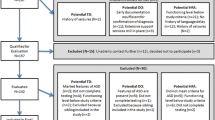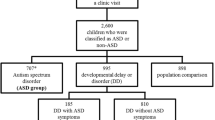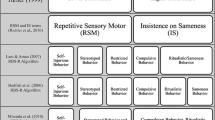Abstract
Questions have been raised about the significance of restricted and repetitive behaviors (RRBs) in predicting outcomes of children with Autism Spectrum Disorders (ASDs). Previous studies have yielded mixed findings, but some suggest that the presence of RRBs during preschool years is a negative prognostic indicator for later childhood. This study examined the effect of RRBs at ages 1–2 and 3–5 years on cognitive functioning, adaptive abilities, and ASD symptomatology at age 8–10 years in 40 children with ASDs. At 1–2 years, RRBs did not predict later functioning. However, at 3–5 years, more severe preoccupations with parts of objects, sensory interests, and stereotyped motor movements predicted less developed cognitive and adaptive skills, and greater ASD symptom severity at age 8–10 years.

Similar content being viewed by others
References
American Psychiatric Association. (2013). Diagnostic and statistical manual of mental disorders (5th ed.). Washington, DC: Author.
Anderson, D. K., Liang, J. W., & Lord, C. (2014). Predicting young adult outcome among more and less cognitively able individuals with autism spectrum disorders. Journal of Child Psychology and Psychiatry, 55, 485–494. doi:10.1111/jcpp.12178.
Ballaban-Gil, K., Rapin, I., Tuchman, R., & Shinnar, S. (1996). Longitudinal examination of the behavioral, language, and social changes in a population of adolescents and young adults with autistic disorder. Pediatric Neurology, 15, 217–223. doi:10.1016/S0887-8994(96)00219-6.
Bishop, S. L., Richler, J., & Lord, C. (2006). Association between restricted and repetitive behaviors and nonverbal IQ in children with autism spectrum disorders. Child Neuropsychology, 12, 247–267. doi:10.1080/09297040600630288.
Bodfish, J. W., Symons, F. J., Parker, D. E., & Lewis, M. H. (2000). Varieties of repetitive behavior in autism: Comparison to mental retardation. Journal of Autism and Developmental Disabilities, 30, 237–243.
Bopp, K. D., Mirenda, P., & Zumbo, B. D. (2009). Behavior predictors of language development over 2 years in children with autism spectrum disorders. Journal of Speech, Language, and Hearing Research, 52, 1106–1120. doi:10.1044/1092-4388(2009/07-0262).
Charman, T., Taylor, E., Drew, A., Cockerill, H., Brown, J., & Baird, G. (2005). Outcome at 7 years of children diagnosed with autism at age 2: Predictive validity of assessments conducted at 2 and 3 years of age and pattern of symptom change over time. Journal of Child Psychology and Psychiatry, 46, 500–513. doi:10.1111/j.1469-7610.2004.00377.x.
Cox, A., Charman, T., Baron-Cohen, S., Drew, A., Klein, K., Baird, G., & Wheelwright, S. (1999). Autism spectrum disorders at 20 and 42 months of age: Stability of clinical and ADI-R diagnosis. Journal of Child Psychology and Psychiatry, 40, 719–732.
Cuccaro, M. L., Shao, Y., Grubber, J., Slifer, M., Wolpert, C. M., Donnelly, S. L., et al. (2003). Factor analysis of restricted and repetitive behaviors in autism using the Autism Diagnostic Interview-Revised. Child Psychiatry and Human Development, 34, 3–17.
Elliott, C. D. (2007). Differential ability scales-second edition (DAS-II). TX: Pearson Education Inc.
Fein, D. A., Barton, M. L., Eigsti, I. M., Kelley, E. A., Naigles, L., Schultz, R. T., et al. (2013). Optimal outcome in individuals with a history of autism. The Journal of Child Psychology and Psychiatry, 54(2), 195–205. doi:10.1111/jcpp.12037.
Fountain, C., Winter, A. S., & Bearman, P. S. (2012). Six developmental trajectories characterize children with autism. Pediatrics, 129, e1112–e1120. doi:10.1542/peds.2011-1601.
Gabriels, R. L., Cuccaro, M. L., Hill, D. E., Ivers, B. J., & Goldson, E. (2005). Repetitive behaviors in autism: Relationships with associated clinical features. Research in Developmental Disabilities, 26(2), 169–181.
Gotham, K., Pickles, A., & Lord, C. (2009). Standardizing ADOS scores for a measure of severity in Autism Spectrum Disorders. Journal of Autism and Developmental Disorders, 39, 693–705.
Honey, E., McConaichie, H., Randle, V., Shearer, H., & Le Couteur, A. S. (2008). One-year change in repetitive behaviors in young children with communication disorders including autism. Journal of Autism and Developmental Disorders, 38, 1439–1450. doi:10.1007/s10803-006-0191-1.
Hus, V., Pickles, A., Cook, E. H., Risi, S., & Lord, C. (2007). Using the Autism Diagnostic Interview—Revised to increase phenotypic homogeneity in genetic studies of autism. Journal of Biological Psychiatry, 61, 438–448.
Lam, K. S. L., Bodfish, J. W., & Piven, J. (2008). Evidence for three subtypes of repetitive behavior in autism that differ in familiality and association with other symptoms. Journal of Child Psychology and Psychiatry, 49, 1193–1200. doi:10.1111/j.1469-7610.2008.01944.x.
Landa, R. J., Stuart, E. A., Gross, A. L., & Faherty, A. (2013). Developmental trajectories in children with and without autism spectrum disorders: The first 3 years. Child Development, 84, 429–442. doi:10.1111/j.1467-8624.2012.01870.x.
Lewis, M. H. (2004). Environmental complexity and central nervous system development and function. Mental Retardation and Developmental Disabilities Research Reviews, 10, 91–95.
Lord, C. (1995). Follow-up of two-year-olds referred for possible autism. Journal of Child Psychology and Psychiatry and Allied Disciplines, 36, 1365–1382.
Lord, C., Luyster, R., Guthrie, W., & Pickles, A. (2012). Patterns of developmental trajectories in toddlers with autism spectrum disorder. Journal of Counseling and Clinical Psychology, 80, 477–489. doi:10.1037/a0027214.
Lord, C., & Paul, R. (1997). Language and communication in autism. In D. J. Cohen & F. R. Volkmar (Eds.), Handbook of autism (pp. 195–225). New York: Wiley.
Lord, C., Risi, S., & Lambrecht, L. (2000). The Autism Diagnostic Observation Schedule-Generic: A standard measure of social and communication deficits associated with the spectrum of autism. Journal of Autism and Developmental Disorders, 30(3), 205–223.
Lord, C., Rutter, M., & Le Couteur, A. (1994). Autism Diagnostic Interview-Revised: A revised version of a diagnostic interview for caregivers of individuals with possible pervasive developmental disorders. Journal of Autism and Developmental Disorders, 24, 659–685.
Mayes, S. D., Calhoun, S. L., Murray, M. J., Morrow, J. D., Yurich, K. K. L., Cothren, S., et al. (2012). Use of the Childhood Autism Rating Scale (CARS) for children with high functioning autism or Asperger syndrome. Focus on Autism and Other Developmental Disabilities, 27, 31–38. doi:10.1177/1088357611406902.
Militerni, R., Bravaccio, C., Falco, C., Fico, C., & Palermo, M. T. (2002). Repetitive behaviors in autistic disorder. European Child and Adolescent Psychiatry, 11, 210–218. doi:10.1007/s00787-002-0279-x.
Mirenda, P., Smith, I. M., Vaillancourt, T., Georgiades, S., Duku, E., Szatmari, P., et al. (2010). Validating the repetitive behavior scale-revised in young children with autism spectrum disorder. Journal of Autism and Developmental Disorders,. doi:10.1007/s10803-010-1012-0.
Mooney, E. L., Gray, K. M., Tonge, B. J., Sweeney, D. J., & Taffe, J. R. (2009). Factor analytic study of repetitive behaviors in young children with pervasive developmental disorders. Journal of Autism and Developmental Disorders, 39, 765–774. doi:10.1007/s10803-008-0680-5.
Moore, V., & Goodson, S. (2003). How well does early diagnosis of autism stand the test of time? Follow-up study of children assessed for autism at age 2 and development of an early diagnostic service. Autism, 7, 47–63.
Mullen, E. M. (1995). Mullen scales of early learning (AGS ed.). Circle Pines, MN: American Guidance Service Inc.
Munson, J., Faja, S., Meltzoff, A., Abbott, R., & Dawson, G. (2008). Neurocognitive predictors of social and communicative developmental trajectories in preschoolers with autism spectrum disorders. Journal of the International Neuropsychological Society, 14, 956–966. doi:10.1017/S1355617708081393.
Paul, R., Chawarska, K., Cicchetti, D., & Volkmar, F. (2008). Language outcomes of toddlers with autism spectrum disorders: A two year follow-up. Autism Research, 1, 97–107.
Perry, A., Condillac, R. A., Freeman, N. L., Dunn-Geier, J., & Belair, J. (2005). Multi-site study of the Childhood Autism Rating Scale (CARS) in five clinical groups of young children. Journal of Autism and Developmental Disorders, 35, 625–634.
Richler, J., Heurta, M., Bishop, S. L., & Lord, C. (2010). Developmental trajectories of restricted and repetitive behaviors in children with autism spectrum disorders. Development and Psychopathology, 22, 55–69. doi:10.1017/S0954579409990265.
Robins, D., Fein, D., Barton, M., & Green, J. (2001). Early detection of Pervasive Developmental Disorders: The modified checklist for autism in toddlers. Journal of Autism and Developmental Disorders, 31, 131–144.
Roid, G. H. (2005). Stanford-binet intelligence scales for early childhood (5th ed.). Rolling Meadows, IL: Riverside Publishing.
Sallows, G. O., & Graupner, T. D. (2005). Intensive behavioral treatment for children with autism: Four-year outcome and predictors. American Journal on Mental Retardation, 110, 417–438.
Schopler, E., Reichler, R. J., De Vellis, R. F., & Daly, K. (1980). Toward objective classification of childhood autism: Childhood Autism Rating Scale (CARS). Journal of Autism and Developmental Disorders, 10(1), 91–103.
Sparrow, S. S., Cicchetti, D. V., & Balla, D. A. (2005). Vineland adaptive behavior scales (2nd ed.). Circle Pines, MN: American Guidance Service.
Stevens, M. C., Fein, D. A., Dunn, M., Allen, D., Waterhouse, L. H., Feinstein, C., & Rapin, I. (2000). Subgroups of children with autism by cluster analysis: A longitudinal examination. Journal of the American Academy of Child and Adolescent Psychiatry, 39, 346–352.
Stone, W., Lee, E., Ashford, L., Brissie, J., Hepburn, S., Coonrod, E. E., & Weiss, B. H. (1999). Can autism be diagnosed accurately in children under 3 years? Journal of Child Psychology and Psychiatry, 40, 219–226.
Szatmari, P., Bryson, S. E., Boyle, M. H., Streiner, D. L., & Duku, E. (2003). Predictors of outcome among high functioning children with autism and Asperger syndrome. Journal of Child Psychology and Psychiatry, 44, 520–528.
Szatmari, P., Georgiades, S., Bryson, S., Zwaigenbaum, L., Roberts, W., Mahoney, W., et al. (2006). Investigating the structure of the restricted, repetitive behaviours and interests domain of autism. Journal of Child Psychology and Psychiatry and Allied Disciplines, 47, 582–590.
Turner, M. (1999). Annotation: Repetitive behaviour in autism: A review of psychological research. Journal of Child Psychology and Psychiatry, 40, 839–849.
Venter, A., Lord, C., & Schopler, E. (1992). A follow-up study of high-functioning autistic children. Journal of Child Psychology and Psychiatry, 33, 489–507.
Acknowledgments
We are grateful for the help of the graduate students and research assistants who aided in data collection and data entry for this study, including Joyce Suh, Kaitlin De Yoe, Courtney Manning, and Chelsea Pajardo. We would also like to thank the parents and children who participated in this study, as well as the funding agencies Maternal and Child Health (R40MC00270-04-00) and the Eunice Kennedy Shriver National Institute of Child Health and Human Development (5 R01 HD039961-05).
Author Contributions
ET made substantial contributions to conception and design of the study, contributed to acquisition of data, performed statistical analyses, and drafted the manuscript; KK made substantial contributions to conception and design of the study, contributed to acquisition of data, and revised the manuscript; LH made substantial contributions to conception and design of the study, contributed to acquisition of data, and revised the manuscript; MS made substantial contributions to analysis and interpretation of data and revised the manuscript; CMC made substantial contributions to analysis and interpretation of data and revised the manuscript; MB made substantial contributions to analysis and interpretation of data and revised the manuscript; KT made substantial contributions to analysis and interpretation of data and revised the manuscript; DF made substantial contributions to conception and design of the study, assisted with interpretation of data, and revised the manuscript. All authors read and approved the final manuscript.
Author information
Authors and Affiliations
Corresponding author
Ethics declarations
Conflict of interest
DF and MB are part owner of the M-CHAT-R LLC. The M-CHAT-R is provided free of charge for physician’s use but provides royalties from companies that incorporate it into commercial products and charge for its use.
Rights and permissions
About this article
Cite this article
Troyb, E., Knoch, K., Herlihy, L. et al. Restricted and Repetitive Behaviors as Predictors of Outcome in Autism Spectrum Disorders. J Autism Dev Disord 46, 1282–1296 (2016). https://doi.org/10.1007/s10803-015-2668-2
Published:
Issue Date:
DOI: https://doi.org/10.1007/s10803-015-2668-2




